
Illegal immigrants constitute a large and growing force in the political, economic, and investment spheres in The United States. The size of this extra-legal segment of the population is significantly understated because the official U.S.Census does not capture the total number of illegal immigrants. In turn, the growth of the underground work force is increasingly concealing the economic impact of this below-market labor supply. Our research has identified significant evidence that the census estimates of undocumented immigrants may be capturing as little as half of the total undocumented population. This gross undercounting is a serious accounting issue, which could ultimately lead to government policy errors in the future.
Though we cannot conduct an independent census of the United States population, as investors, we need not accept the accuracy of the official census immigration statistics, which are widely recognized as incomplete. There are many ancillary sources of data that provide evidence that the rate of growth in the immigrant population is much greater than the Census Bureau statistics. School enrollments, foreign remittances, border crossings, and housing permits are some of the statistics that point to a far greater rate of change in the immigrant population than the census numbers. At the risk of appearing dogmatic or taking a leap of faith, we have applied the rate of growth from these other areas and have drawn several conclusions about the current immigration population:
- The number of illegal immigrants in the United States may be as high as 20 million people, more than double the official 9 million people estimated by the Census Bureau.
- The total number of legalized immigrants entering The United States since 1990 has averaged 962,000 per year. Several credible studies indicate that the number of illegal entries has recently crept up to 3 million per year, triple the authorized figure.
- Undocumented immigrants are gaining a larger share of the job market, and hold approximately 12 to 15 million jobs in the United States (8% of the employed)
- Four to six million jobs have shifted to the underground market, as small businesses take advantage of the vulnerability of illegal residents.
- In addition to circumventing the Immigration Reform and Control Act of 1986, many employers of illegal workers have taken to using unrecorded revenue receipts. Employer enforcement has succumbed to political pressure.
- Cell phones, internet and low-cost travel have allowed immigrants easier illegal access to the United States and increased their ability to find employment and circumvent immigration laws.
We believe that immigration is becoming one of the most significant economic themes of this decade. The investment implications for 2005 and 2006 will hinge on the forthcoming government policy decisions in amnesty, employer enforcement, and monitoring systems, as well as the effective enforcement of the laws. Over the coming year, we intend to monitor and analyze the benefits and costs of assimilating a demographic group the size of New York State into the financial and legal mainstream. Though this challenge is not quite the magnitude of, say, German reunification, we believe most investors are underestimating the magnitude and significance of this theme.
The growing extralegal system in the United States has distorted economic statistics and government budget projections. The stealth labor force has enhanced many of the economic releases that investors follow closely. Payroll numbers understate true job growth and inflation has been artificially dampened by this seemingly endless supply of low-wage workers. The large infusion of the imported labor supply has reduced average annual earnings by approximately 4 to 6 percent. Real estate prices have been boosted by the foreign population infusion. The productivity miracle may be exaggerated because the government is incorporating the output of millions of illegal immigrants but not counting their full labor input. Long-term budget projections are probably overstating the potential growth of the U.S. economy because productivity is inflated. Or, stated differently, are long-term growth projections dependent on a steady flow of illegal immigration that no one is taking into account?
As census procedures improve and the immigration numbers are revised closer to reality, many of these questions will be answered, and public perceptions will change. Many government forecasts, policies and procedures will be modified to compensate for the undercounting. The public sector will incur significant costs in assimilating a reclassified population. An abrupt increase in employer enforcement could have a negative impact on GDP. In the short-term, an adjustment to immigration policies could squeeze small business profits and increase the budget deficits. Longer-term, we believe the effects will be more balanced as this invisible work force provides aid to the demographic problems of social security. Increased enforcement of legal employment procedures should also boost tax revenues.
The implications of these massive inflows of workers are enormous. Although there are economic benefits to cheap, illegal labor, there are significant costs associated with circumventing the labor laws. The social expenses of health care, retirement funding, education and law enforcement are potentially accruing at $30 billion per year. Many of these costs lag and will not be realized until the next economic downturn and beyond as new immigrants require a safety net.
On the revenue side, the United States may be foregoing $35 billion a year in income tax collections because of the number of jobs that are now off the books. Illegal aliens offer below market labor costs and many employers circumvent regulations to take advantage of the laissez faire government enforcement process. We estimate that approximately 5 million illegal workers are collecting wages on a cash basis and are avoiding income taxes.
The United States is simply hooked on cheap, illegal workers and deferring the costs of providing public services to these quasi-Americans. Illegal immigration has been America's way of competing with the low-wage forces of Asia and Latin America, and deserves more credit for the steroid-enhanced effect it has had on productivity, low inflation, housing starts, and retail sales.
From a personal standpoint, our research does not take sides with any of the emotional arguments of the Crossfire mindset. We are grateful to have had the opportunity to speak with immigrants, local business owners, realtors, and police officers. This project afforded us the opportunity to see into the past and look into the future of the United States.
The Census Bureau estimates that 8.7 million people are illegally residing in the United States, while the Urban Institute estimates a total of 9.3 million people. The Current Population Survey (CPS), a joint project of the Bureau of Labor Statistics and the Census Bureau, puts the number at 9.2 million. In a recent report released in November 2004, the Center for Immigration Studies (CIS) stated that the CPS could have missed as many as 10% of illegal aliens, suggesting a total illegal population of 10 million as of March 2004. We believe that these estimates fall short. The Census Bureau's counting process for the migrant population has some shortcomings. According to our discussions with illegal immigrants, they avoid responding to census questionnaires. For this reason, the official estimates do not fully capture this group. The CPS, the Census Bureau, the Urban Institute, and the former INS (now part of the Department of Homeland Security) all use similar processes to determine the total number of immigrants, and which immigrants should be categorized as legal and illegal. In essence, this has created a circular equation that relies on a singular source of inaccurate statistics that gives the impression of independent, multiple verifications.
According to a recent study by the Migration Research Unit, University College London, a wide range of methods have been used to measure immigration flows, which by definition eludes registration and statistical coverage. "Estimating the numbers of illegal resident persons in a country is a task made extremely difficult by the unrecorded nature of the phenomenon, by the problems of the data that are recorded and the different definitions, data sources, collection methods and legislative differences between countries. The dynamism and fluctuation in the size of the illegal population is as much related to the intricacies of the immigration law as to the movements of the migrants themselves." Studies of methods used to calculate the illegal population have concluded that no existing method "provides a well-founded or rigorous method by which to measure the illegal population."
The Congressional Budget Office acknowledges "deriving estimates of the number of unauthorized, or illegal, immigrants is difficult because the government lacks administrative records of their arrival and departure, and because they tend to be undercounted in the census and other surveys of the population. Unauthorized immigrants generally fall into one of two categories: those who entered the United States illegally and without inspection and those who were admitted legally as visitors or temporary residents but overstayed their visa."
According to Maxine Margolis, author of An Invisible Minority: Brazilians in New York City, the discrepancies started well over a decade ago. The 1990 census, for example, recorded only 9,200 Brazilians in New York City, while the local Brazilian consulate estimated 100,000 Brazilians at that time. The Brazilian foreign office placed the number at 230,000; Dr. Margolis also noted that comparisons of the Boston Archdiocese and Brazilian consulate records with U.S. census records show a startling 10 to 1 difference.
The latest census taken in 2000 significantly revised the number of illegal immigrants upward versus 1990 projections. The INS also increased their estimates. Upward revisions to such projections have been a consistent trend.
Regardless of the politics of immigration, getting an accurate read on the size of the current wave is important. Tax collections, budget projections and school capacity planning are a few of the public sectors functions that rely on accurate head counts. Eventually, the official statistics will catch up with the new reality that global migration is exploding. When population and labor force statistics are properly synchronized, we will see an impact on financial markets, economic statistics and social policy.
These revisions will bring some difficult decisions to the surface, as it seems that we have been living in a state of denial for almost a decade. If indeed, the number of illegal immigrants is 20 million people, approximately the equivalent of New York State, any amnesty or legalization and assimilation process will require significant public sector resources.
Illegal immigrants work very hard to conceal their identities and successfully avoid being counted. Even apprehended illegal migrants will hide important personal data on their status to avoid removal. Census officials and academics underestimate the ingenuity and the efficiency of the communications network among immigrants. Understandably, illegal immigrants go to great lengths to maintain a low profile and conceal their identities, not only for census purposes, but for tax purposes as well. The risk-reward trade of dodging census inquiries is severely skewed. Migrants that pay large portions of future earnings to gain entry into the United States make the sacrifice of leaving their families behind, or have trekked through physical obstacles and thousands of miles; accordingly, they have no downside risk in discarding census surveys.
Employers also have incentive to hire undocumented workers off the books, taking advantages of inefficient immigration enforcement. The competitive winds of deflation from overseas labor markets have forced U.S. employers to find extra-legal, innovative ways to capitalize on sources of cheaper labor to stay competitive. These employers have, in turn, placed pressure on the government to ignore the flood of cheap labor. INS enforcement of employer violations has decreased dramatically over the last five years. This trend is counter intuitive, given the substantial rise in illegal immigration during a new era of national security.
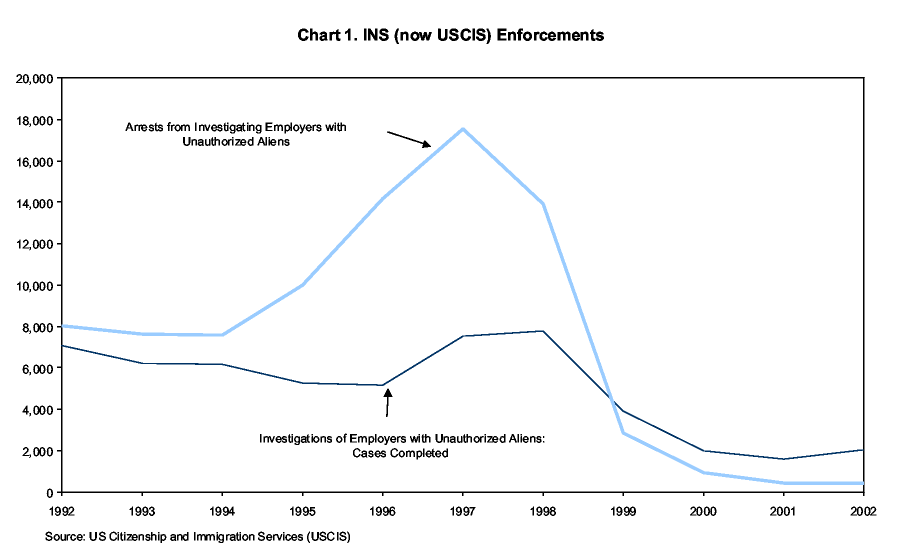
The strongest evidence supporting our theory that the actual illegal population is double the consensus estimates lies within several micro trends at the community level. We see very dramatic increases in services required in communities that have become gateways for immigration. States with high populations of undocumented immigrants have experienced extra demand for public services. The top nine states, California, Texas, Florida, New York, Illinois , New Jersey, Arizona, Georgia and North Carolina account for approximately 50% of the undocumented population. Although the federal government has the sole authority to govern immigration flows, the responsibility for providing support to legal and illegal immigrants rests with the state and local governments
The de facto administration at the state and local level reinforces our premise that we must look at local statistics to extrapolate the most reliable headcount of immigrants. The increases in services, including public school enrollment, language proficiency programs, and building permits all point to a rate of change far greater than the census numbers would imply for the demand for these local services. The growth in these areas indicates that more people are moving into these communities than the official estimates.
Based on several criteria, we believe that immigration is growing significantly faster than the consensus estimates:
- Remittances
- Housing permits in gateway communities
- School enrollment
- Cross border flows
Many immigrants, particularly those with immediate families in their native country, provide financial support to those left behind. Remittances are surging because many immigrants send home on average $1,400 to $1,500 per year through money transfers. In 2002, people sent $133 billion worldwide, according to the World Bank. Developing countries accounted for $88 billion of the total, up 33% from $60 billion in 2000. Countries that are experiencing migration outflows are having very large increases in remittances. Remittances from the United States to Mexico have tripled to $13 billion between 1995 and 2003. For Mexico, this is an important source of funds that has surpassed foreign direct investments and tourism receipts in 2003, and is second only to petroleum export revenues.
Most importantly, this explosion in remittances is not consistent with the estimates of legal and illegal immigrants from Mexico. The rate of increase in remittances far exceeds the increases in Mexicans residing in the U.S. and their wage growth. Between 1995 and 2003, the official tally of Mexicans has climbed 56%, and median weekly wage has increased by 10%. Yet total remittances jumped 199% over the same period. Even considering the declining costs of money transfers, the growth of remittances remains astounding.
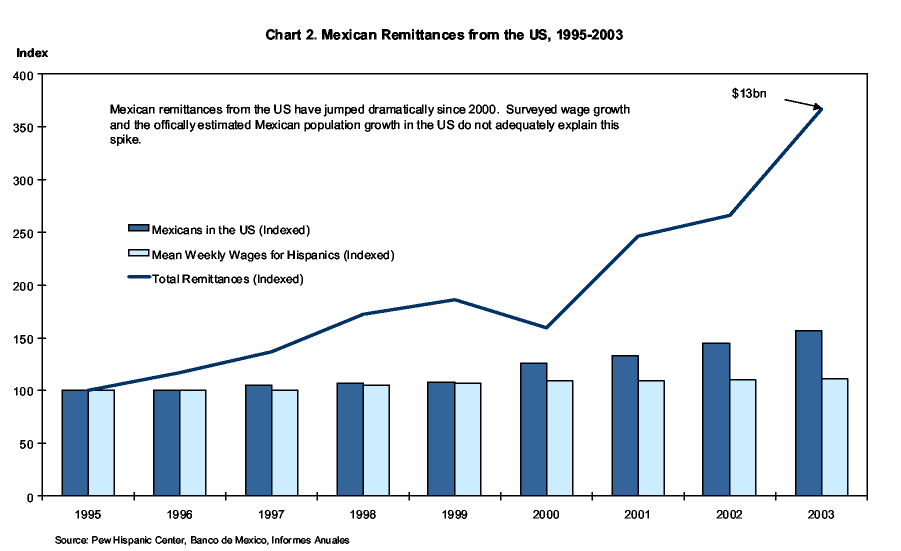
The rapid addition of bank accounts by Mexicans living in the U.S. is also revealing. According to the Pew Hispanic Center, 39% of surveyed Latino immigrants cited legal status as a concern for opening bank accounts. This motivates many immigrants to remit cash through private money centers such as Western Union and Money Gram, which charge very high fees. Since late 2001, however, many major banks including Citibank, Bank of America, and Wells Fargo Bank began accepting matriculas, photographed identity cards for Mexicans living in the U.S. These cards show the local addresses of the holders, and any legal or illegal Mexican can obtain it at one of the 45 Mexican consulates across the country. The removal of legal status as a concern for opening and using bank accounts has led to a boom in retail business for some banks. Wells Fargo opens an average of 700 new accounts everyday based on this identification, representing the fastest growing segment for the bank. To date, around 2.5 million matriculas have been issued, and the number is growing.
In major immigrant gateway cities, the influx of immigrants has led to overcrowded dwellings and a housing boom unexplained by official population growth. Many illegal immigrants, especially those who just arrive, reside in congested dwellings in cities, with the hope of finding jobs and upgrading to better living conditions later. These congested dwellings often house far more tenants than they are built for, and their landlords have no qualms about cramming in additional renters for a surcharge. Even so, new housing demand in these illegal immigrant enclaves outstrips those in other areas.
In New Jersey, the three gateway towns of New Brunswick, Elizabeth, and Newark exemplify this trend. According to the census, the combined population in these three towns between 1990 and 2003 grew only 5.6%, less than the 9% reported in the rest of the three corresponding counties. Yet housing permits in these three towns shot up over six-fold, while the rest of the three counties only saw a three-fold increase. More importantly, 80% of these permits were designated for multiple dwellings, so the corresponding increase in people accommodated are even greater. Official statistics state that illegal immigrants in New Jersey have jumped 110% during the same period — an estimate that is inconsistent with the housing statistics, our discussions with local realtors and the changes that we have visually observed in the demographic landscape.
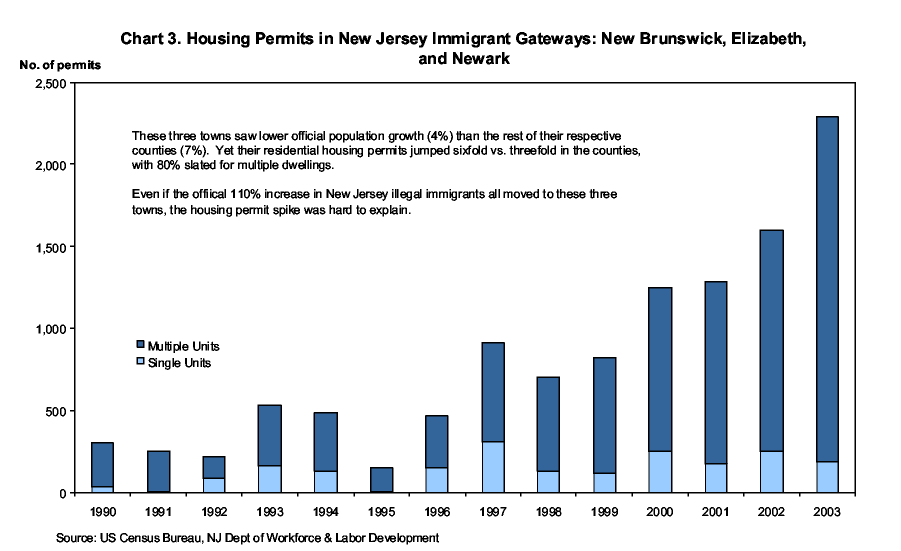
The major immigration gateways have experienced school enrollments much higher than projections. The decrease in the number of births in the past decade had led education administrators to expect decreasing school enrollments as a post echo boom trend. A higher immigration rate, however, has offset the impact of declining births. The enrollment statistics for a sample of school districts that included Queens, New York, Elizabeth, Newark and New Brunswick, New Jersey and Wake County in North Carolina revealed explosive growth in immigrant students, far beyond numbers consistent with legal migration limits.
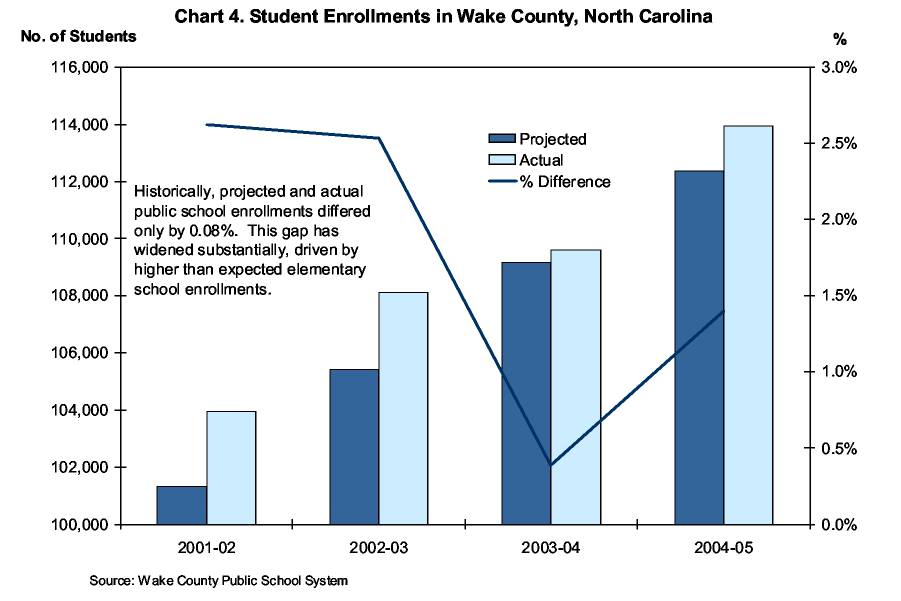
According to the Urban Institute, children under 18 comprise approximately 17% of the undocumented population, with only half attending school, making the sharp increases in school enrollment more telling. We can extrapolate that for every undocumented immigrant child in the public school system, there are potentially 8 to 9 additional undocumented men, women and children living in the United States.
In New York City, nearly one-quarter of the general population is under the age of 18. Approximately 55% of these children were enrolled in grades pre-K-12 in the 2001-2002 school year. It appears that the ratio of illegal immigrant school children to adults is much lower than the general population, and understandably so. Historically, the transition of illegal immigrants is lead by single males, followed by single females, who establish a presence, a job and home before starting a family or relocating other family members from their native countries.
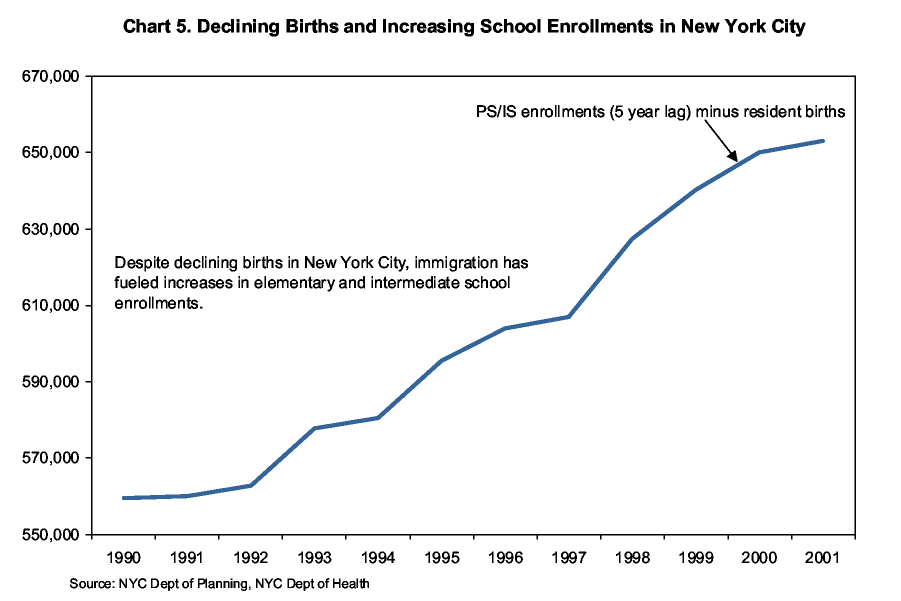
With a total enrollment of 1.1 million students, the NYC public school system is the largest in the nation. Immigrant student enrollment for the 1998-2001 period was 103,000, with Queens accounting for the largest share, 37,000. Between 1990 and 2001, more than half of New York City's school districts increased their enrollments 10% or more, driven by a high number of immigrant students.
Demographic and enrollment trends according to the New York City Public Schools system state:
- "To a significant degree, high rates of immigration offset the effect of a declining number of births on school enrollment." Administrators have been surprised that school population growth significantly exceeded earlier projections, thus creating overcrowding in many school districts.
- "In the three-year period from 1999 to 2001, 102,867 immigrant students registered for grades pre-K-12 in New York City Public Schools, with many predominant countries of origin, other than Mexico, including the Dominican Republic, China, Jamaica, Mexico, Pakistan, Ecuador, Colombia and Haiti."
Pulitzer Prize reporters Donald L. Barlett and James B. Steele recently reported for TIME magazine that "the number of illegal aliens flooding into the United States this year will total 3 million. It will be the largest wave since 2001 and roughly triple the number of immigrants that will come to the U.S. by legal means." The TIME investigation, according to Mr. Barlett, relied not only on figures projected by the U.S. Border Patrol, but also on the reporter's extensive investigations along the Mexican border at factories, local communities, and the district offices of the U.S. Border Patrol.
Though more resources have been designated to patrolling the Mexican border, TIME argues that "the government doesn't want to fix it, and the politicians, as usual, are dodging the issue, even though public opinion polls show that Americans overwhelmingly favor a crackdown on illegal immigration." It can be strongly argued that enforcement at the work place is a much more efficient way of controlling illegal flows because the primary incentive for sneaking into the United States is money and jobs. A telephone verification system was designed under the auspices of the Immigration Reform and Control Act of 1986 for employers to confirm the legal status of potential employees. As of today, this system is still not running.
The world is undergoing the largest migration wave since the late 1800's. Over 175 million people are in motion. The dramatic increase in human mobility has left the public sector and policy makers behind. The specific and general understanding of migration flows has not kept pace with the growth, complexity and implications of this phenomenon. The economic implications of demographics have increased tremendously over the last 20 years. In no other time period during the last century have demographics undergone such a subcutaneous change in the United States.
The human race is on the move — human mobility is increasing drastically, according to the International Organization for Migration (IOM), the Population Division of the United Nations. It estimates the total number of international migrants is approximately 175 million or 2.9% of the world population. The migration wave has two components — transnational and rural to urban, and these waves are changing the dynamics of government, economics and lifestyles more than any other driver of human behavior.
Governments are seriously behind in recording and comprehending the current phenomenon, and more importantly, governments are making economic and social policy decisions based on flawed information. Like corrupt corporate accounting practices or poor national security information, the United States is struggling with its immigration policies because of false assumptions and unreliable data.
The importance, rightfully or wrongfully, that markets place on economic data can be demonstrated in the bond market reactions to employment releases. Employment releases are like earnings releases in that investors count on the information to be accurate, within a reasonable margin of error, so that good analysis can lead to prudent evaluations of risk and reward.
In the case of household employment numbers, there is a 90% confidence interval for monthly changes in employment, which equates to a margin of error of approximately plus or minus 350,000. A 350,000 margin of error on a labor force of 135 million people is acceptable, but the current migration wave is distorting total employment by the millions, we believe. This presents serious statistical problems that can lead to faulty investment decisions. Unless the government and investors get the numbers on immigration correct, the market will fail to grasp the extent of the required policy changes. The consequent adjustments could be drastic and disruptive to the bond market.
To a large extent, U.S. immigration policy is adhoc, according to Robert Shiller, Stanley B. Resor Professor of Economics, Yale University:
The system that developed countries currently use to keep people from less- developed countries out is inefficient. The United States has strict immigration policies but lax enforcement; so many people manage to slip illegally over the border. Once here, the illegal immigrants pay dearly in terms of quality of life. Then, periodically, the United States considers granting amnesty to illegal immigrants. This is a crazy system, and we could imagine a better one that could someday handle immigration.
Belated policy responses no doubt complicate efforts to assess the number of illegal migrants. However, the focus on the migration issue is growing. The profile of the immigration topic is rising in the media, the legislature, and in grass root movements. Many documentary and feature films are exploring the immigration themes. State and local governments and medical institutions in the gateway states are being financially impacted by the increased demand generated by these new American residents. Arizona's Proposition 200 may represent a new trend to address the state and local strains associated with this unanticipated and underestimated population growth. We expect that the coverage, the tangential issues and the political emotions will be magnified in 2005. In this paper, we have merely outlined what we see as the magnitude of the current migration wave. We have barely touched on the economic and investment implications. In the coming months, we will explore further the specific relationship between public policy, enforcement and the more specific implications for the economy and the bond markets.